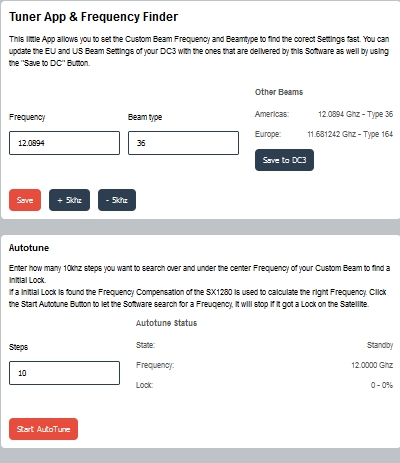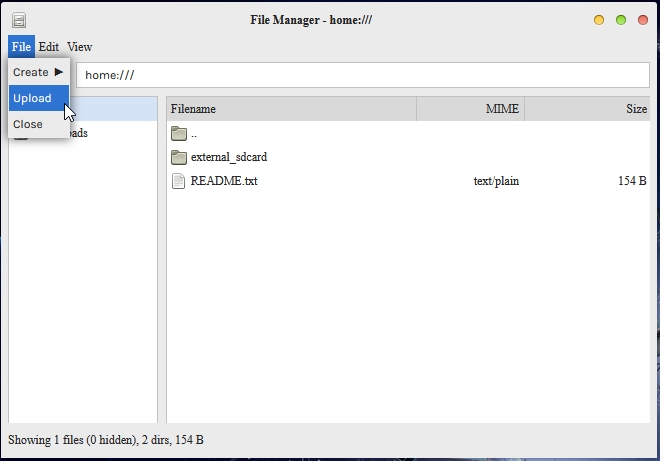We tried bringing up the carrier today, but we had a problem with our equipment. It shouldn’t be a problem, because we are doing the exact same thing in the US-teleport, but so it goes. We are looking into it now and are scheduled to try again tomorrow morning at 9AM-Chicago/UTC 14:00.
that’s sad 
Information for European Users is posted here from the Revised User’s Guide. It has been very helpful to many of us in North America, and when modified for the Eutelsat 8WB Frequency and Beam Type should be helpful.
Fine Tuning Information for European Users
We are including this information (from the March 14th User’s Guide) you may find useful in bringing up your Dreamcatchers when the Frequency and Beam Type are announced.
Step 5. Selecting and Fine Tuning the Correct Operating Frequency in North America and Europe.
Here’s where it gets a bit difficult if the Bias-T voltage is OK and you sited your LNB correctly. Because Othernet is now using a narrower bandwidth (reduced from 800kHz to 200 kHz), it is more difficult to select the correct operating frequency for each LNB since they all respond a little differently. Even if you correctly site your antenna, you may not be able to receive until you fine tune the Dreamcatcher’s operating frequency. It is also possible that you have not sited your LNB correctly, so triple check that first.
Go to the Status TAB Fig. 23 and see what you have, then perform this very important routine if it is still blank.
Just keep in mind that even on paper, the packets won’t appear with an offset greater than 25% (50 kHz). So far we’ve noticed that 25 kHz of offset is a pretty reliable window, but your mileage may vary. It is said the Maverick will work - - but some Forum Members have been unable to achieve lock with it . The offset is probably just much farther out. Please keep in mind that most commercially available DTH LNBs are specified to a 1,000,000 Hz offset (aka +/- 1000 kHz).
The Maverick was issued with Dreamcatcher 3.02Q, one of the first units we were using on the KU band. It has a stability of ± 1Mhz. With the Dual LO Single LNB, issued with Dreamcatcher 3.05, the stability is ± 200 Khz. With Bullseye LNB (soon to be released with a new Dreamcatcher Version), it is ± 10 Khz.
In Step 5a below, the fine tuning process has been automated If you want to perform the fine tuning manually, read Optional Step 5b .
Step 5a. Automated Process Forum member @Tysonpower has also developed an App for Skylark now in the downloads:////Apps Folder Fig. 22 that automates the above process and is shown in Fig. 21a. You can also download it from @Tysonpower 's web site at DC3 Frequency Finder

Fig. 21a Frequency Finder App Version 1.1
If you chose not to run the APP from downloads:////Apps Folder, but rather install the APP in your Skylark program, you must use log on Othernet (Guest won’t work). You can then upload it to your Skylark Program micro SD card or to your external micro SD card from your computer. Keep in mind if you upload the file into the home:///directory , it gets deleted when you reboot your Dreamcatcher so you would have to reinstall it. If you have external storage, upload it there to keep it permanent. When you run it, it takes some time to complete, so watch its status timer.

You will need to find the file to upload on your computer after you click the Upload TAB
Optional Step 5b . Manual Process With no reception shown and being correctly pointed to the satellite, go back to the Custom TAB and increment the frequency by 5,000 Hz (.000005 GHz) or 10,000 Hz (.00001 GHz) - - then go back to the Satellite TAB and click APPLY. There is no need to close the Tuner Icon and reopen it even thou the Freq shown in the Satellite TAB will not have changed - - the Tuner will have retuned. Go to the Status TAB to see if you are receiving. If not, add another 5,000 Hz (which is .000005 GHz)
In this example on the North American satellite starting at 12.0894 GHz, the frequency was incremented19 times by 5,000 Hz = 95,000 Hz to get some sort of Status. Your Custom Freq setting would now be 12,089,400,000 Hz plus 95,000 Hz or 12.089495 GHz added in increments of 5,000 Hz. Be PATIENT!

As you approach the optimum Freq, your flashing Status Screen will start showing no Lock with fluctuating SNRs and Rssi (or maybe going in and out of Lock). When you get consistent Lock, take a look at the Freq Offset (Hz)
In this example, we started at 12.0894 GHz and got Lock at 12.089495 GHz after 19 trys. The Freq Offset (Hz) shown above requires adding another 15,193 Hz more to this 12,089,495,000 Hz to get a final Freq setting of (12.089495 GHz + .000015193 GHz) = 12.089510193 GHz which will have the least Freq Offset (Hz). It is 12.089510193 we would enter in the Custom TAB now - then click APPLY in the Satellite TAB. If the Freq Offfset (Hz) was negative, you would subtract it. Keep in mind we added almost 100 kHz to our LNB Frequency to get a good link!
Step 5c. Once you have set the Dreamcatcher’s operating frequency correctly, Slowly physically move your LNB to maximize the SNR (dB) making it as large (less negative) as possible.
Step 5d. The Tuner Status screen in Fig. 23 will show the SNR (dB) line fluctuating at a value above -14 dB (sometimes as high as + 10 dB), the Lock line saying yes , and the Rssi (dBm) line fluctuating at a value between -60 and -95 dBm. Lower Rssi levels such as -100 dBm may carry signal, but the Dreamcatcher is not sensitive enough below -95 dBm. On the top of the Tuner Status Screen, you will see what type file is being downloaded at that moment - - either audio or files . At the very bottom of the screen you will see what file is being downloaded or just finished downloading at any time. This picture represents a successful connection at latitude 39 deg N longitude 76 deg W in mid afternoon with an accurately pointed LNB, and a fine tuned LNB Additionally, LED 6 will be fast blinking dim green if data packets are detected.

Fig. 23 Tuner Running Correctly on SES-2 at Latitude 39 degrees N
In theory, it’s all working now. We will find out again tomorrow morning.
Is the beam type the same as in the US? (36). MIght have a go after breakfast.
Yes, the target is to use beam type 36. We may need to adjust that if the downlink power is not sufficient.
Everyone, don’t forget to re point antennas as the new satellite is at a different location. Ken
right now i have set up a 85cm satellite dish pointed at E8WB with a Bullseye LNB. Weather conditions are overcast and rainy, and a 50 step sweep around the center frequency does not come up with a signal lock, even if i shouldn’t have to sweep considering the bullseye lnb stability.
System status and BIAS-T are ok according to the log viewer.
I verified i am indeeed on E8WB with a sat meter on 12543 V|DVB-S|2222-1/2 (Test card ‘Marqueur’)
We haven’t gone up yet. It’s possibly related to a bandpass filter that was tuned to the incorrect frequency. Still working through this.
Can’t wait. I’ll keep the receiver running on the center frequency. And keep an eye on the status screen.
Ok, so the problem was definitely related to the filter. It’s been adjusted and we do have a clean carrier. Now just waiting for bring up.
yes, no lock, but offset “2120” SNR is -40 db on the satellite dish.
You are using a dish? If so, something is wrong.
Yes, i described the setup earlier. 85cm, pointed and Skew adjusted to +10db on a DVB Signal.
With such narrow beam width from an 85cm dish, you should only be seeing the Othernet carrier. SNR at -40 means that the SX1281 is giving a garbage value. The two garbage values I often see are -40 and -160.
The auto tuner is homing on on the signal, getting better… Im receiving files now.
But it couldn’t lock with offset at just 2120 Hz?
right now it’s strange, the tuner stays at -40, stream ‘unknown’ but files are coming in.